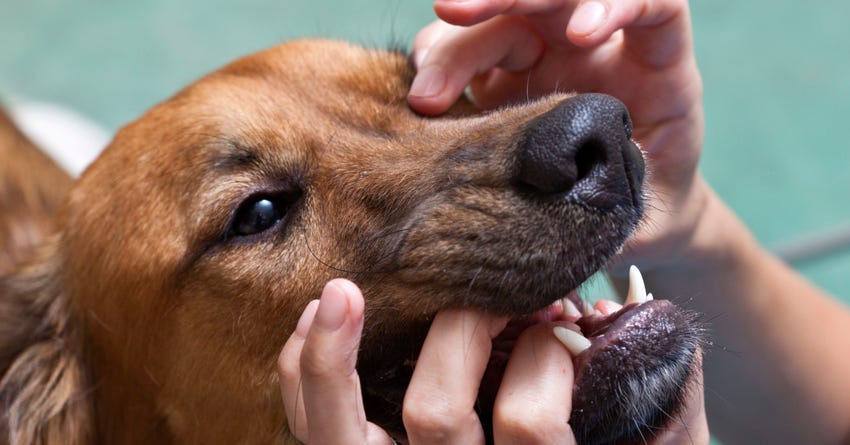Does Fido always have bad breath or does Fluffy show difficulty chewing her food? If so, your pet likely has periodontal disease.
Periodontal disease, one of the most common diseases diagnosed in veterinary practice, can be irreversible and has serious health consequences. According to Veterinary Pet Insurance (VPI), “more than 80 percent of pets in the U.S. experience gum disease by age three.” Additionally, the American Veterinary Dental Society (AVDS) reports 4 out of 5 pets live with dental disease. Owners should strive to prevent periodontal disease as part of our pet’s daily wellness routine.
What is Periodontal Disease and How Does it Develop?
Periodontal disease primarily affects the gums, teeth, and the supporting structures of the teeth. Secondarily, internal organs are negatively impacted by periodontal disease. It all starts with bacteria, as tooth surfaces are coated with a thin layer of plaque (bacteria) hours after eating or cleaning. Within days, plaque accumulates and becomes yellow tartar that’s visible to the naked eye. Weeks later, tartar mineralizes into shell-like calculus. Gingivitis (gum inflammation) develops throughout the process and permits easier entry of bacteria into the bloodstream. Periodontitis (bone loss) ultimately occurs, which weakens the tooth’s attachment to the underlying alveolar bone. Periodontal disease has four stages: Stage 1 Gingivitis—redness at the gum margin and presence of bad breath Stage 2 Early periodontitis—less than 25% support loss Stage 3 Established periodontitis—between 25-50% support loss Stage 4 Advanced periodontitis—greater than 50% support loss
Recommended Reading: Cat Have Bad Breath? Here Are Common Causes and Helpful Remedies
Besides the Mouth, Are Other Organ Systems Affected?
Periodontal disease has health consequences beyond bad breath and tooth loss. Vital organs including the heart, kidneys, liver, and pancreas are affected. Additionally, the immune system becomes taxed by the constant need to prevent oral cavity bacteria from entering the body and is less able to perform day-to-day functions like tissue repair and stress management. A study published in the Journal of Alzheimer's Disease established an association between mouth bacteria and the development of Alzheimer’s disease in humans, so there’s likely a comparable correlation occurring in the mouths and brains of dogs and cats having periodontal disease. Overall, your pet’s entire body is negatively affected by periodontal disease, especially as the condition progresses to Stage 3 and 4. Permitting the condition to go untreated increases the probability that internal organ damage will occur. Additionally, tooth loss or the need for extractions is more likely with advanced periodontal disease.
How is Periodontal Disease Treated?
Owners can assess their cat or dog’s degree of periodontal disease by gently lifting the muzzle (“lips”) and pulling back the cheek margins on both the right and left side to look for evidence of tartar, calculus, and gingivitis that may not be apparent when the mouth is closed or partially open. If such changes are seen, then your pet needs a professional evaluation, cleaning, and possibly other treatments (tooth extraction, etc.). The most thorough dental cleaning is performed when a pet goes under general anesthesia, which permits cleaning under the gumline, thorough teeth polishing, x-ray assessment of the attachment to the teeth and underlying bone, and dental extractions (if needed). Pets having mild periodontal disease and those that are very cooperative may be candidates to have their teeth cleaned without going under anesthesia (non-anesthetic dental) provided it’s done by a veterinarian or certified veterinary technician. General anesthesia is actually the safer procedure, in part because it involves the use of an endotracheal tube to deliver oxygen and anesthetic gas directly into your pet’s respiratory tract. The endotracheal tube protects the trachea (“windpipe”) and lungs from infection by mouth bacteria aerosolized when a scaling device removes plaque, tartar, and calculus from the teeth. Additionally, there’s no struggling on the part of the animal patient who may not be so appreciative of the attempt to scale his teeth. Gingivitis and dental disease occurring under the gumline are painful conditions, so any procedures used in their attempted resolution will cause your pet to experience discomfort that otherwise could be avoided during an anesthetic procedure. By the way, your pet is never “too old for anesthesia.” He certainly can be “too unhealthy,” but there’s never a “too old” status that should prevent you from most-thoroughly addressing his dental disease. Would Grandma not go under anesthesia to have surgery to resolve a potentially life-threatening problem just because she’s 80? I think not. Your veterinarian’s physical exam and diagnostics tests (blood, urine, and fecal testing, x-rays, ultrasound, etc.) can diagnose normal or abnormally functioning organs (heart, lungs, kidneys, liver, etc. and determine if your pet is or is not a good anesthetic candidate. Of course, sick patients can be made healthier so that anesthesia will be safely performed under the guidance of an experienced veterinarian and veterinary technician team.
How Can Periodontal Disease Be Prevented?
Fortunately for our pets, an owner’s dedication to home dental care can prevent periodontal disease from occurring or slow its progression. Teaming with your veterinarian is best so that a plan to resolve your pet’s periodontal disease and prevent it from reoccurring can be established. I recommend my patients go under anesthesia for dental x-rays and a thorough cleaning to establish a healthy baseline. Once this has been achieved, then an owner can diligently strive to prevent his pet’s periodontal disease from recurring. Even prior to the planned dental procedure, daily home care should be started to inhibit the worsening of a pet’s current condition. Daily brushing with a moistened, soft-bristle brush can be very effective. Using pet-appropriate toothpaste, gels, and wipes can remove tartar and kill bacteria. Pet-safe dental chews can also clean teeth, but should not be used in lieu of brushing. Recommended Reading: How to Clean Your Cat's Teeth (And Keep Them Clean!) Seek your veterinarian’s guidance and establish a plan to resolve your pet’s periodontal disease and prevent it from reoccurring. If your veterinarian isn’t able to completely address your pet’s dental disease, seek a referral to a veterinary dental specialist familiar with treating challenging cases (you can locate one in your area via the ACVD Veterinary Dentist Directory). Ultimately, the quality of life and longevity of your canine or feline companion depends on your dedication to preventing and resolving periodontal disease.

